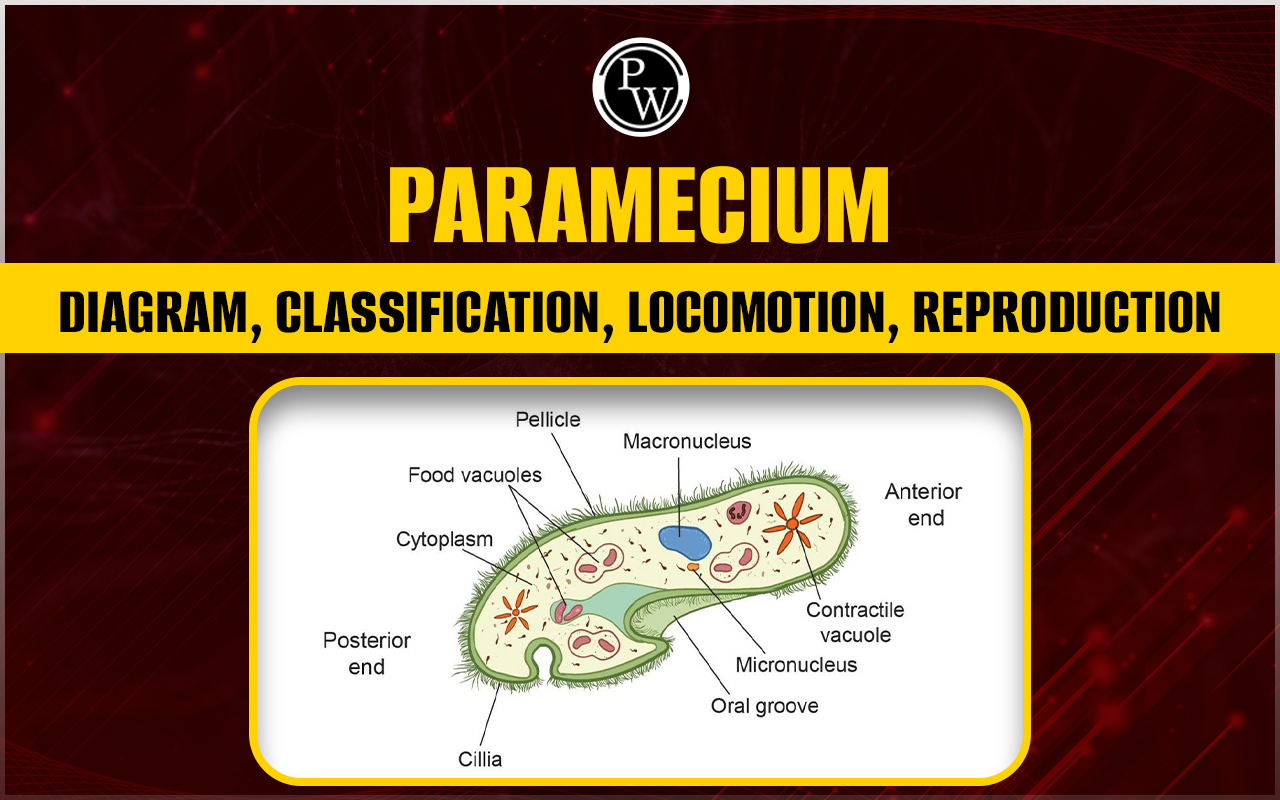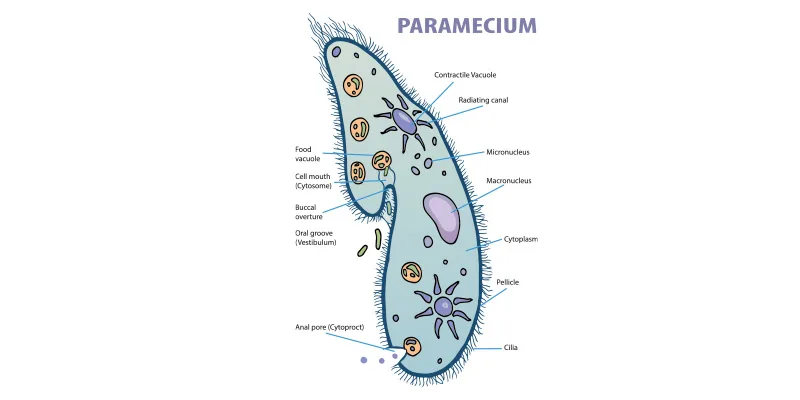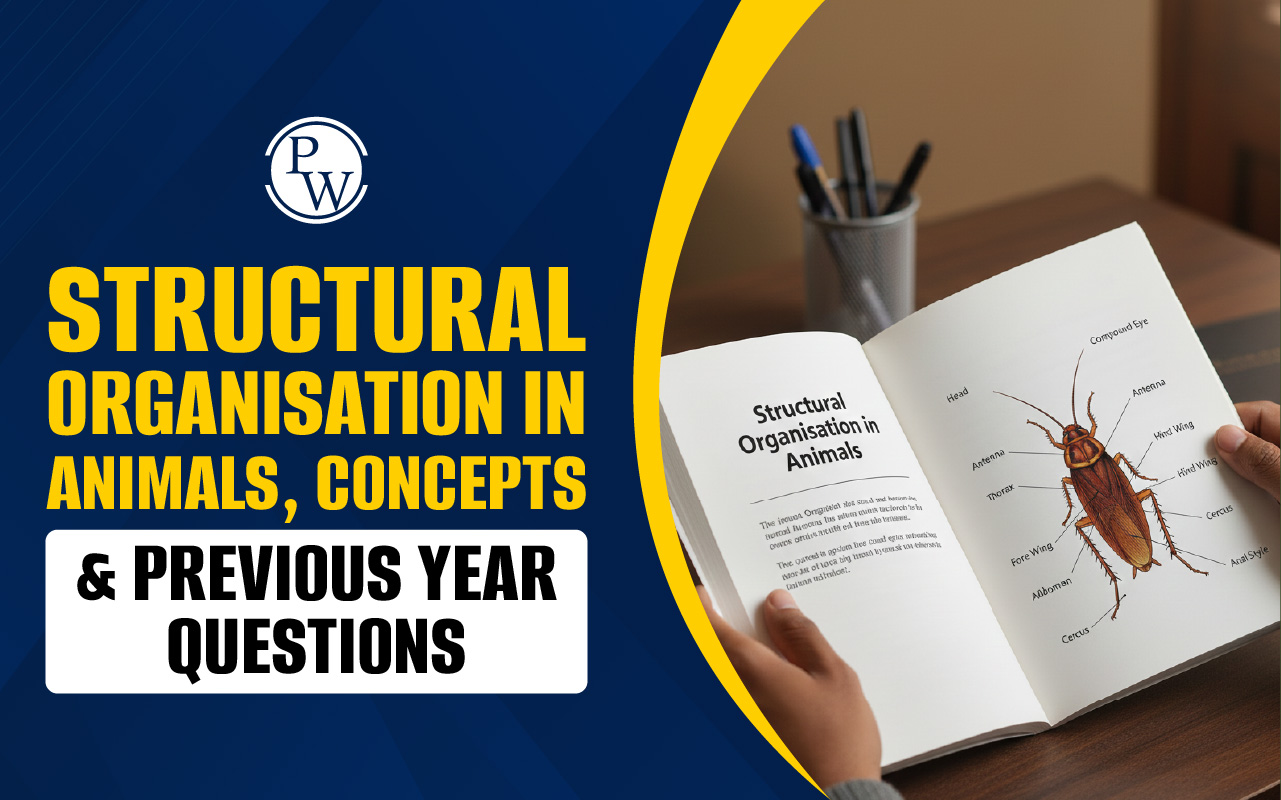

Paramecium: Paramecium, also known as Paramoecium, is a genus of single-celled protozoans with cilia on their bodies. They live in freshwater, marine, and brackish water environments, frequently attaching to surfaces. Paramecium was among the first ciliates discovered by microscopists in the late seventeenth century. They were most likely known to Antonie van Leeuwenhoek, a Dutch protozoologist, and described by his contemporary Christiaan Huygens in 1678. Paramecium reproduction is primarily asexual, such as binary fission, but it also exhibits conjugation. Paramecium is easily grown and commonly used in biological research. The article below details on the paramecium notes for the NEET exam.
Paramecium Diagram
The paramecium diagram is shown below for a better understanding of its paramecium structure:

Paramecium Kingdom
Paramecium belongs to the Kingdom Protista, which is made up primarily of unicellular organisms that do not fit into the traditional classifications of plants, animals, or fungi. Protists are extremely diverse, including algae and protozoans like Paramecium. They are mostly found in aquatic environments like freshwater, marine habitats, and moist terrestrial areas. Despite being unicellular, many protists exhibit complex behaviors and structures, making them fascinating subjects for scientific study.
Paramecium Size
Paramecium size and structure can be examined under a microscope. Although most microscopic organisms are small, some are large enough to be seen without magnification. Most species range between 50 and 330 micrometers (μm) in length. This size range is approximately equal to the width of a human hair.
Paramecium are single-celled organisms with a distinct slipper shape that can be seen under the microscope. They are covered in tiny, hair-like structures called cilia, which play an important role in movement. These cilia beat together, allowing the paramecium to move gracefully through its watery environment.
The study of paramecium under the microscope has helped us advance our understanding of biology. These organisms have long been used as model organisms in biological research, providing important insights into cellular processes and behaviours.
- Micrometers (μm): 50 - 330 μm
- Millimeters (mm): 0.05 - 0.33 mm
- Inches: 0.002 - 0.013 inches
Paramecium Classification
Paramecium is a single-celled organism with a well-defined nucleus, placing it in the eukaryotic category. As a result, it is classified in the Protista kingdom. Paramecium is characterized by the presence of cilia and belongs to the Ciliophora phylum. Paramecium is classified as follows:
- Kingdom: Protista
- Phylum: Ciliophora
- Class: Oligohymenophorea (or Litostomatea)
- Genus: Paramecium
The various species of Paramecium include:
- Paramecium aurelia
- Paramecium caudatum
- Paramecium woodruffi
- Paramecium trichium
Paramecium Characteristics
Paramecia are microscopic organisms that can be seen with the naked eye. They are commonly referred to as slipper animalcules because of their slipper-like appearance. These single-celled organisms have several different components:
- Cilia: Hair-like fibers that cover the entire body of the Paramecium. Cilia are essential for locomotion and gathering food.
- Pellicle: A flexible, firm, and thin membrane that covers and protects the entire body of the Paramecium. It is elastic and composed of gelatinous material.
- Cytostome: This structure consists of several parts, including:
- Oral Groove: A large, shallow, oblique depression located on the ventrolateral side of the Paramecium, giving it an asymmetrical shape.
- Cytopyge: A part that helps in the elimination of undigested food.
- Cytoplasm: A jelly-like material that fills the interior of the Paramecium and exists within the ectoplasm.
- Ectoplasm: A thin, clear, and dense layer containing cilia, fibrillar structures, and trichocysts.
- Endoplasm: This part contains various granules, including mitochondria, food vacuoles, and nuclei.
- Trichocysts: Small, bottle-shaped structures contained within the cytoplasm and filled with refractive fluid.
- Nucleus: The nucleus of a Paramecium is divided into two parts, the micronucleus and the macronucleus. Reproduction in Paramecium typically involves the transformation of the nucleus. However, Caudatum, a type of Paramecium, does not contain a nucleus.
- Vacuole: Paramecia possess two types of vacuoles, food vacuoles, and contractile vacuoles. Food vacuoles aid in the digestion of food, while contractile vacuoles are involved in excretion, respiration, and osmoregulation.
Paramecium Locomotion
Paramecium move using a method known as ciliary locomotion, which requires some complex steps:
- Cilia: These are small, hair-like structures covering the entire body of the paramecium. They play a crucial role in its movement.
- Beating Pattern: The cilia beat in a coordinated, wave-like motion, similar to a field of wheat swaying in the wind but on a microscopic scale. This beating pattern includes an effective stroke that pushes water backward and a recovery stroke that returns the cilia to their starting position.
- Propelling Motion: Paramecia use their cilia to create water currents that propel them forward in a gliding or rolling motion.
This process enables paramecia to navigate their environment, find food, and avoid obstacles.
Some additional facts about paramecium locomotion are:
- Direction Change: Paramecia can reverse their direction by changing the direction of their cilia beating.
- Sensory Response: The beating of cilia can be influenced by the environment. For example, if a paramecium encounters an unfavorable stimulus, the cilia might beat in a way that causes it to reverse direction or move away.
Paramecium Reproduction
Asexual reproduction, specifically binary fission, is the main method of reproduction for paramecia when environmental conditions are favorable, such as when food is abundant. Here is the detailed process:
- Cell Division: A mature paramecium elongates, and its internal structures duplicate.
- Micronuclear Division: The micronucleus, which contains genetic information for inheritance, undergoes mitosis, resulting in two identical daughter nuclei.
- Macronuclear Division: The macronucleus, responsible for daily cell functions, divides through a simpler process called amitosis. This process does not result in perfect copies, but it is sufficient for asexual reproduction.
- Cell Separation: The paramecium cytoplasm pinches in two, separating the cell into two daughter cells, each containing a macronucleus and a micronucleus.
- Growth and Maturity: The daughter cells then mature and grow into independent paramecia.
This process allows for rapid population growth under ideal conditions.
Sexual reproduction in paramecia occurs through various methods:
- Conjugation in paramecium: Two complementary paramecia (syngen) come together, and there is a transfer of genetic material. An individual must undergo asexual reproduction 50 times before being able to reproduce through conjugation in paramecium.
- Process of Conjugation: During conjugation, a conjugation bridge forms between the two paramecia, which are then known as conjugants. Both cells' macronuclei disappear, and each conjugant's micronucleus undergoes meiosis to form four haploid nuclei. Three of these nuclei degenerate, and the remaining haploid nuclei fuse to form diploid micronuclei, allowing for cross-fertilization. The conjugants then separate to form exconjugants, which are identical but different from their previous cells. Each exconjugant undergoes further division to form four daughter paramecia, and new macronuclei are formed from the micronuclei.
- Autogamy: Paramecia also undergo autogamy, or self-fertilization, which leads to the production of a new macronucleus, increasing their vitality and rejuvenating them.
- Cytogamy: Cytogamy is less common, where two paramecia come into contact but do not exchange nuclei. In this process, paramecia rejuvenate, and a new macronucleus is formed.
Paramecia that do not undergo conjugation age and die after 100-200 cycles of fission. Clonal ageing, which is due to DNA damage, is primarily responsible for this process.
| Other NEET Biology Topics | ||
|---|---|---|
| Ribosomes | Pollination | Apomixis |
| Centrosome | Embryo | Tissues |
Paramecium in Hindi
पैरामीशियम एकल-कोशिका सिलिअटेड प्रोटिस्ट की एक प्रजाति है, जो फ़ाइलम सिलियोफोरा से संबंधित है। ये जीव आम तौर पर अंडाकार, चप्पल के आकार के या लम्बे होते हैं। पैरामीसिया मीठे पानी के वातावरण में प्रचुर मात्रा में हैं और सूक्ष्मजीव समुदायों का एक अनिवार्य हिस्सा हैं। वे सिलिया का उपयोग करके अपनी अनूठी हरकत और अपने भोजन व्यवहार के लिए प्रसिद्ध हैं, जिसमें भोजन के कणों को उनके मौखिक खांचे में डालने के लिए सिलिया का उपयोग शामिल है।
Paramecium Unicellular or Multicellular
Paramecium is a unicellular organism, which means it consists of a single cell. This single cell performs all of the organism's survival functions, including movement, feeding, digestion, and reproduction. Unlike multicellular organisms, Paramecium lacks specialized tissues or organs; instead, different parts of a single cell perform these functions. Paramecium belongs to the Protista kingdom, primarily composed of unicellular eukaryotic organisms.
Physics Wallah's NEET Online Courses provide comprehensive coaching for NEET exam preparation, with a variety of courses at reasonable prices. Physics Wallah is well-known for offering high-quality NEET Online Coaching in India at competitive prices, ensuring access to superior coaching.
| NEET Exam Important Links | |
|---|---|
| NEET Syllabus | NEET Biology Diagrams |
| NEET Biology MCQ | NEET Biology Chapter wise Weightage |
| NEET Biology Notes | NEET Previous Year Question papers |
Paramecium FAQs
Is Paramecium a type of bacteria?
What is Paramecium?
Which phylum does Paramecium belong to?
Do Paramecium eat bacteria?
Who discovered Paramecium?












